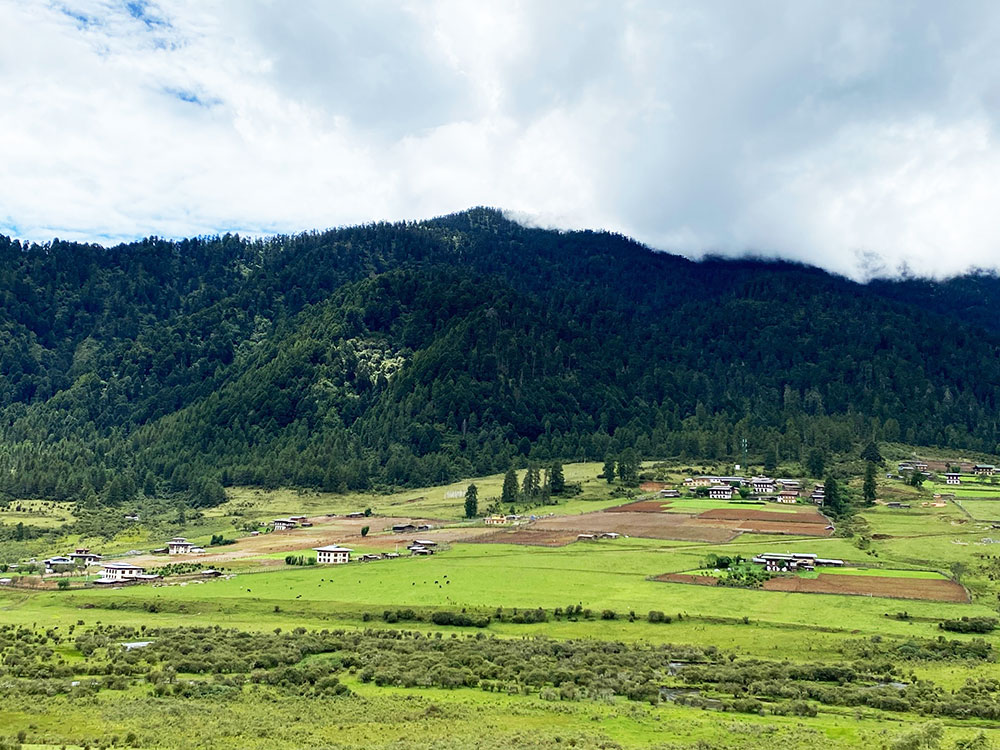Phurpa Lhamo | Wangdue
A few years ago, villagers in Sangtana in Gangtey gewog complained about ABC Lodge discharging grey water directly into the wetland, threatening the black-necked cranes and their habitat.
A staff from the ABC Lodge said that the lodge had a separate tank for the grey water discharge and only kitchen water flowed into the dug hole before entering the wetland area.
Another farmer in the village complained that his neighbour’s grey water flow into the stream and then into the wetlands.

RSPN and CNR officials are studying the quality of water in the valley
Today, a drain meanders in between households in Sangtana village, then in front of the ABC Lodge, and into the wetland area.
A villager in Sangtana said that the wastewater flowing into the wetland and the stream was a concern for villagers because the stream flow near the four households.
He added that animals drink straight from the water. “The neighbour also rents the place and the grey water from the house directly flowed into the streams.”
Similarly, usage of pesticides and weedicides in potato cultivation in Gangtey and Phobjikha gewogs is worrying local leaders.
While complains and concerns among villagers and the local leaders continue, there is no study to prove if the settlement and their activities have an impact on the crane habitat.
However, with the on going study by Royal Society for Protection of Nature (RSPN) and the College of Natural Resources (CNR), much of these questions would be answered.
National Coordinator for BNC conservation Jigme Tshering said that the study would look at the streams and the composition from which it could be determined what was being dumped into the wetland.
Based on the data collected so far, CNR Dean Om Katel (PhD), said that the wetland area was significantly shrinking and the flow of the streams was lower in winter.
He added that the second conclusion from the study showed that the bamboos, which once grew in abundance in the area had decreased due to bamboo flowering, a phenomenon that occurred every 12 years.
“After the bamboo flowering happened, the whole valley’s ecosystem has changed; the bamboo shoots are coming up but there are livestock grazing in almost all the area.”
Om Katel said the growing concern was that weeds were replacing the empty spaces where once the bamboos grew.
He added that fewer bamboos meant less safety and food for the cranes, while the replacing weeds meant more habitats for wild animals such as wild dogs. “We will try to understand if the use of pesticides expedite growth of other invasive species. There are weeds which are growing profusely.”
The project will also look into means to remove these invasive species.
The interviews also showed that the farmers of the valley were of understanding that the increased population and vehicles in the valley had resulted in warmer weather and less snowfall.
Today, local leaders of Gangtey and Phobji gewogs are discouraging usage of pesticide and weedicide.
In Phobjikha, a good agriculture practice (GAP) involving usage of only recommended amount of chemicals in the fields is being tested by the local leaders.
A farmer in Gangtey, Tshering Wangchuk, said that usage of chemicals had decreased in the valley.
He added that in the past, on his one-acre land, around seven bags (50kg each) of fertilizers, weedicides and pesticides were used. “Now we use around four bags in one acre land.”
The study led by students and staff of CNR was supposed to begin in July last year. However, due to the pandemic, data collection began in April this year.
The study is expected to be completed by December this year.
Edited by Jigme Wangchuk


